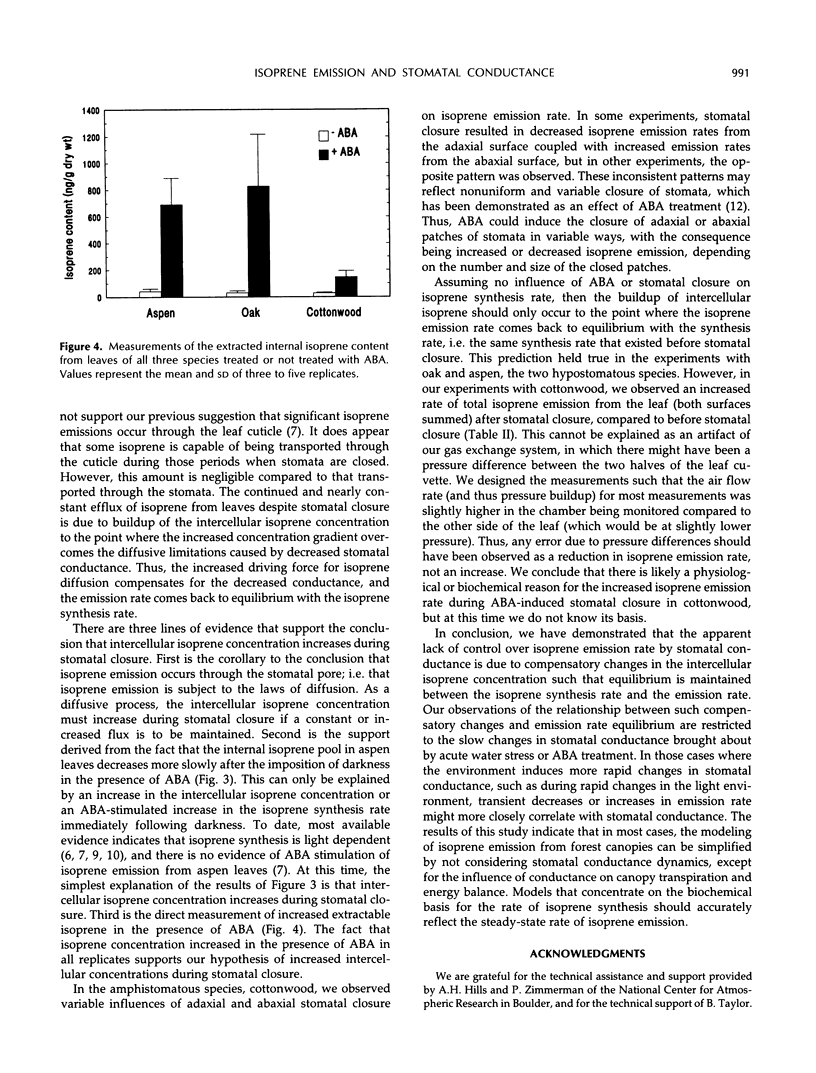Abstract
Isoprene emission in relation to stomatal distribution and conductance was determined for the hypostomatous species, aspen and white oak, and the amphistomatous species, cottonwood. For aspen and oak, isoprene emission from the adaxial (nonstomatal) surface was <2% of that from the abaxial (stomatal) surface, even when stomata were closed by addition of abscisic acid (ABA). When treated with ABA, the total flux rate of isoprene emission from leaves of these two hypostomatous species was unchanged, despite decreases in stomatal conductance of over 90%. The lack of control over isoprene emission rate by stomatal conductance, despite the apparent movement of isoprene through the stomatal pores, was due to increases in the intercellular isoprene concentration that compensated for the decreased stomatal conductance and restored the equilibrium between the isoprene synthesis rate and emission rate. This relationship was demonstrated by (a) an experiment in which the decrease in the internal isoprene pool following the imposition of darkness took longer in the presence of ABA than in its absence, and (b) direct measurements of the internal isoprene concentration through vacuum extraction, which revealed substantially higher values in the presence of ABA than in its absence. In the amphistomatous species, cottonwood, isoprene was emitted from both surfaces and addition of ABA caused an increase in isoprene emission from one surface coupled with a decrease from the other surface. The specific surface exhibiting an increase varied among leaves, with some leaves exhibiting an increase from the adaxial surface and other leaves from the abaxial surface. We interpret this as indicating nonuniform stomatal closure with concomitant emission of isoprene at the greatest rate from the surface with the highest stomatal conductance. We also observed an increase in the total isoprene emission rate from cottonwood leaves following treatment with ABA. We interpret this as indicating a stimulation of isoprene synthesis in response to ABA or stomatal closure, with unknown cause.
Full text
PDF





Selected References
These references are in PubMed. This may not be the complete list of references from this article.
- Chameides W. L., Lindsay R. W., Richardson J., Kiang C. S. The role of biogenic hydrocarbons in urban photochemical smog: Atlanta as a case study. Science. 1988 Sep 16;241(4872):1473–1475. doi: 10.1126/science.3420404. [DOI] [PubMed] [Google Scholar]
- Monson R. K., Fall R. Isoprene emission from aspen leaves : influence of environment and relation to photosynthesis and photorespiration. Plant Physiol. 1989 May;90(1):267–274. doi: 10.1104/pp.90.1.267. [DOI] [PMC free article] [PubMed] [Google Scholar]
- Silver G. M., Fall R. Enzymatic synthesis of isoprene from dimethylallyl diphosphate in aspen leaf extracts. Plant Physiol. 1991 Dec;97(4):1588–1591. doi: 10.1104/pp.97.4.1588. [DOI] [PMC free article] [PubMed] [Google Scholar]


